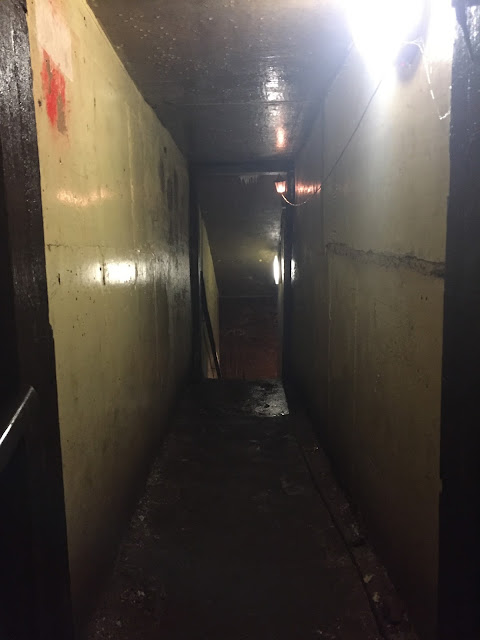Williamson Tunnels: Link to the website
"The Williamson Tunnels Heritage Centre is the only tourist attraction in Liverpool dedicated to 19th Century philanthropist Joseph Williamson.
Opened in 2002 the Williamson Tunnels Heritage Centre has welcomed over 100,000 visitors into the fascinating underground world created beneath the streets of the Edge Hill district of Liverpool by Joseph Williamson, a wealthy tobacco merchant who employed many hundreds of men in the construction of a huge and elaborate underground labyrinth of tunnels, chambers and passageways.
Visitors to the Williamson Tunnels Heritage Centre can take a guided tour through a section of the network of tunnels and view exhibits and displays which depict the life and times of one of Liverpool's most eccentric characters.
Visitors to the Williamson Tunnels Heritage Centre can take a guided tour through a section of the network of tunnels and view exhibits and displays which depict the life and times of one of Liverpool's most eccentric characters.
The Williamson Tunnels Heritage Centre is owned and operated by the Joseph Williamson Society.(Registered Charity No: 1062091)
The Joseph Williamson Society is a registered charity which receives no public funding, therefore, the Society relies entirely on visitor income and donations to maintain and develop the Williamson Tunnels Heritage Centre."
The space that can be hired:
The tunnels:
I think it is a very interesting environment to show work in. It has character, history and no plain white gallery wall to display work - which is exciting and challenging at the same time. They have tours for general public in the tunnels which i find very interesting. Especially seeing how passionate the people who volunteer there are about the tunnels and the tours and the extension and development of them. They are volunteers so don't get paid for their work. They run events in the hiring space at the end of the tunnels which are used for number of things, for example raves, music groups, lectures etc
The number of times i have visited the tunnels i was welcomed and the people were positive in what i had in mind for the space. They are open minded and that is great to hear as a creative.
I came up with a group of 10 individuals from my course, 1st and 2nd years, who are interested in responding to the space and produce work for it.
List of artists:
1st year - Lucy Jane Smith
1st year - Jon Edgley
1st year - Callum Morley
1st year - Danielle Waine
2nd year - Vinny Quirk
2nd year - Eryn Gross
2nd year - Wayne Shaw
2nd year - Osian Fletcher
2nd year - Rory Larbalestier
2nd year - Ellie Hoskins
+ me
These artists produce a range of work from different disciplines (sound, sculpture, painting, performance, interactive etc) and it will be very exciting to see what we as a group and as individuals can produce for this exhibition. I am aiming to have as many group discussions possible every week to discuss the development of this project and listen to individual needs and communicate throughout so everybody is happy in what we are doing.
We are planning to have the exhibition sometime in April which is yet to be discussed both with the tunnels and the group.
In the first meeting what i really wanted to discuss with the group is what space they are keen in using - the tunnels themselves or the hiring space at the end of the tunnels which is used for all kind of events. Personally i am keen on having an exhibition in the tunnels themselves, where there are tours for general public, sounds more appealing to me than just using the hiring space to show work. It also sounds more demanding in terms working around the tours and the limitations of the space e.g. hanging artwork on the walls. The work in the tunnels need to be placed in a way that does not block the tour path or in any way damage the tunnels themselves. The walls and the whole of the space is damp which could be and negative and a positive as well, as we can use the dampness and natural conditions of the space to our advantage.
So far i think we have determined as a group that we will be showing in the tunnels where tours happen, responding to the space and creating work for it. The hiring space at the end of the tunnels will be used for socialising on the day of the private view which will be for one or two hours. It might also be the space used by Jon Edgley for his piece of interactive work if he decides to follow with it. The rest of the work will be shown in the tunnels. As the tunnels close at 5pm and the last tour is at 4pm, we might want to have our private view running from 4-6pm or 5-7pm depending on the discussions i will have with the staff there and how much we can afford. The private view will be for one night only and the work in the tunnels might stay longer, for a couple of days if it isn't in the way of the tunnel workers. So again something to discuss with them again.
What also be of our interest os the charity shop next door. What is sold there the money goes back to the tunnels. Maybe we could think about a way of helping the tunnels to gain more money from our exhibition. Maybe the charity shop be of help for that.
We will have our next meeting on Friday 26th at 4:15pm in the tunnels to discuss our thoughts and ideas further, when we will have the chance to explore the space together.
I am very excited and i hope the group is too!
~Ev









